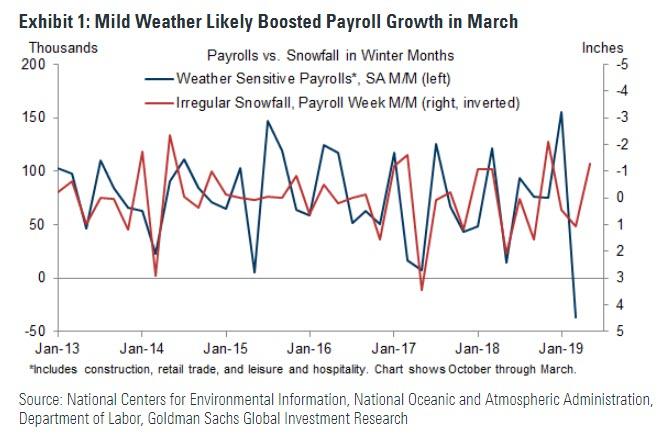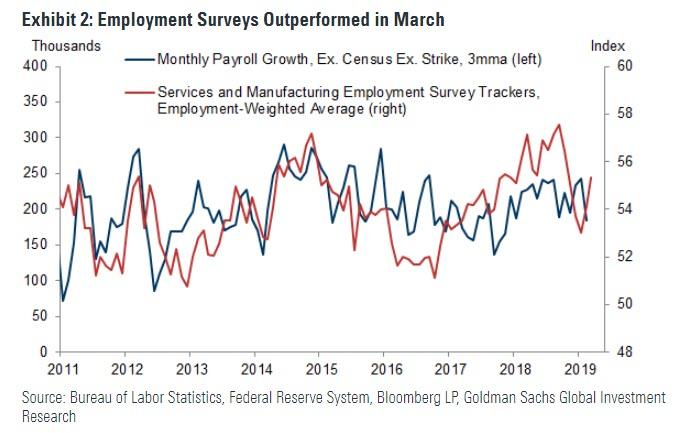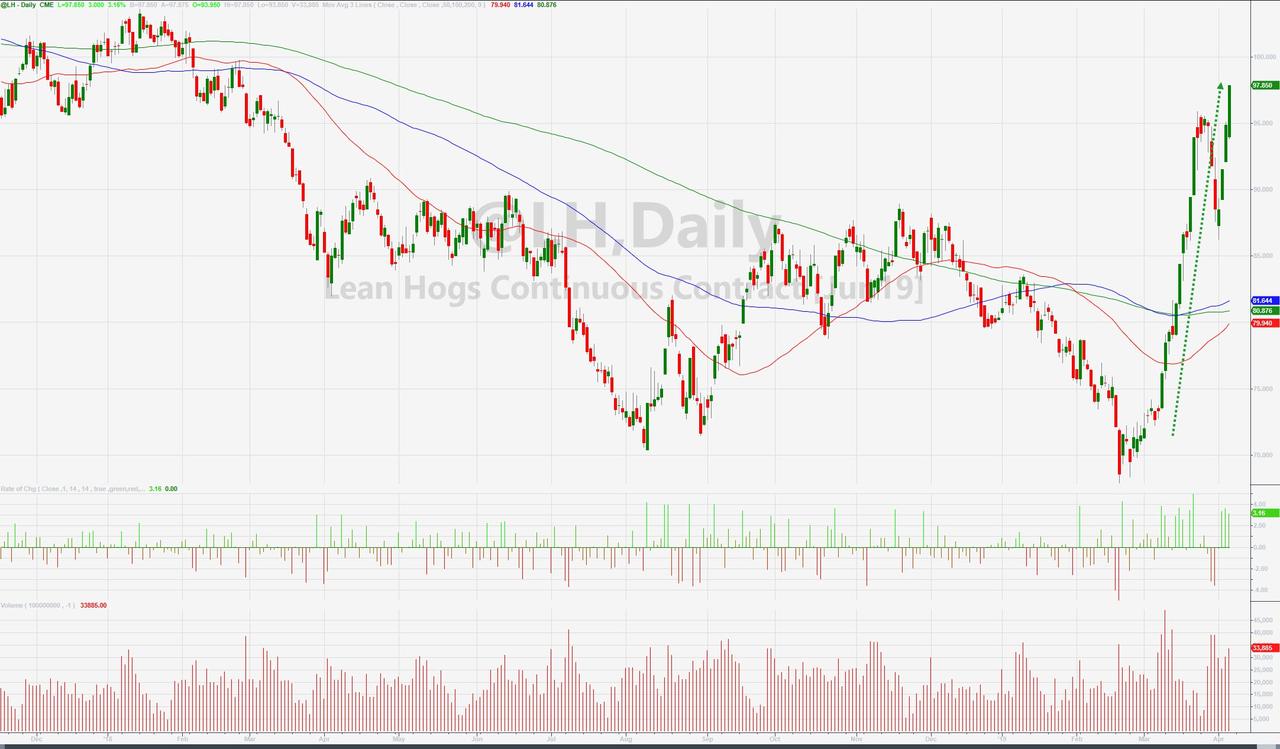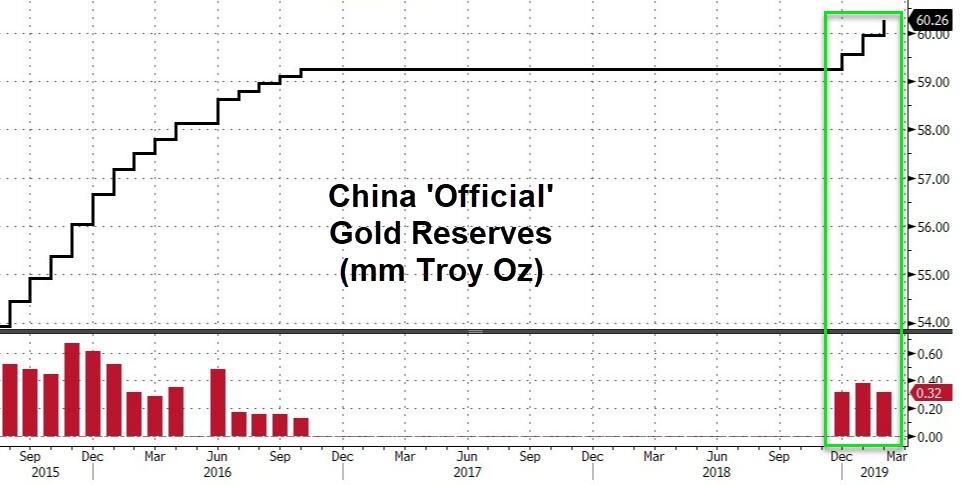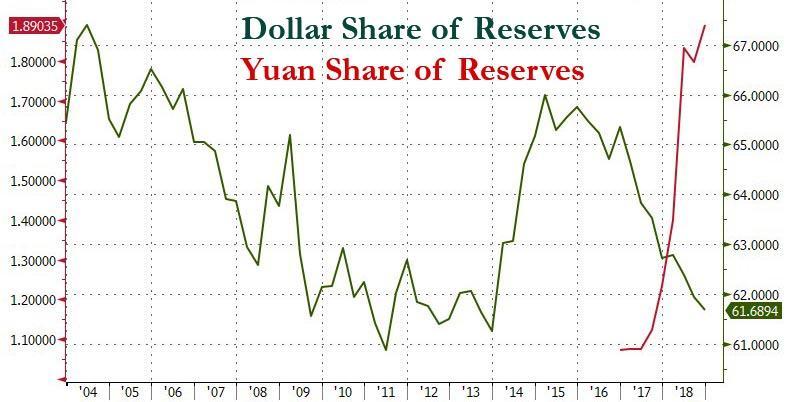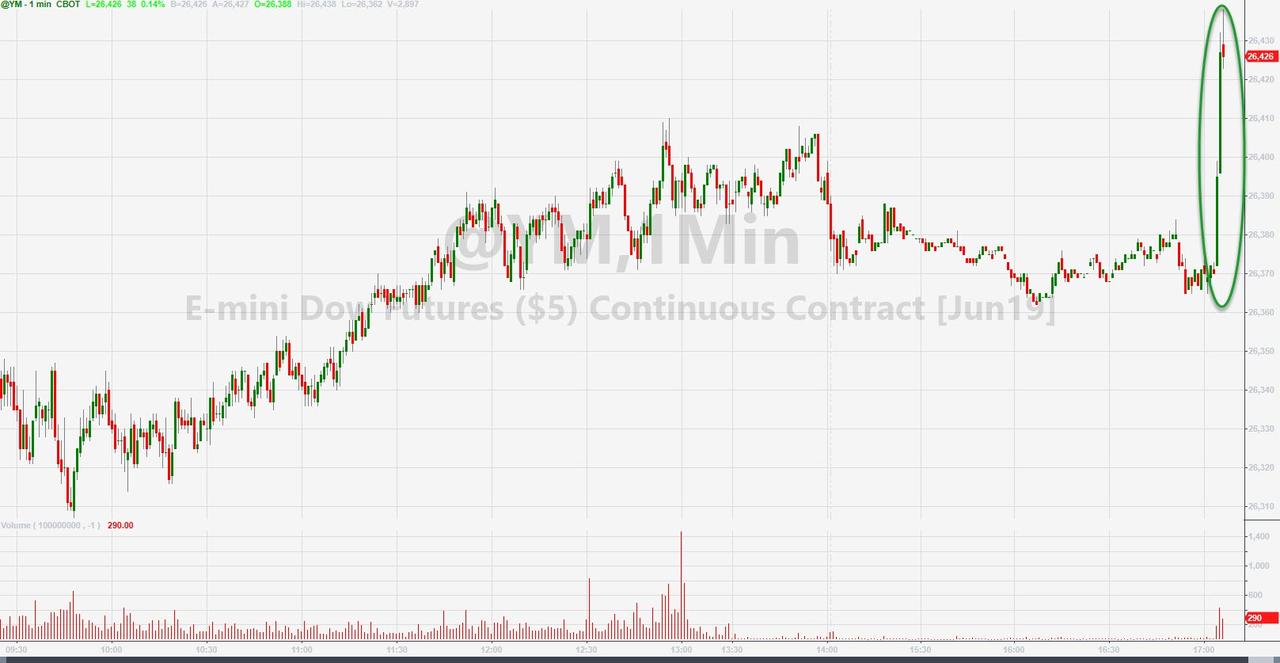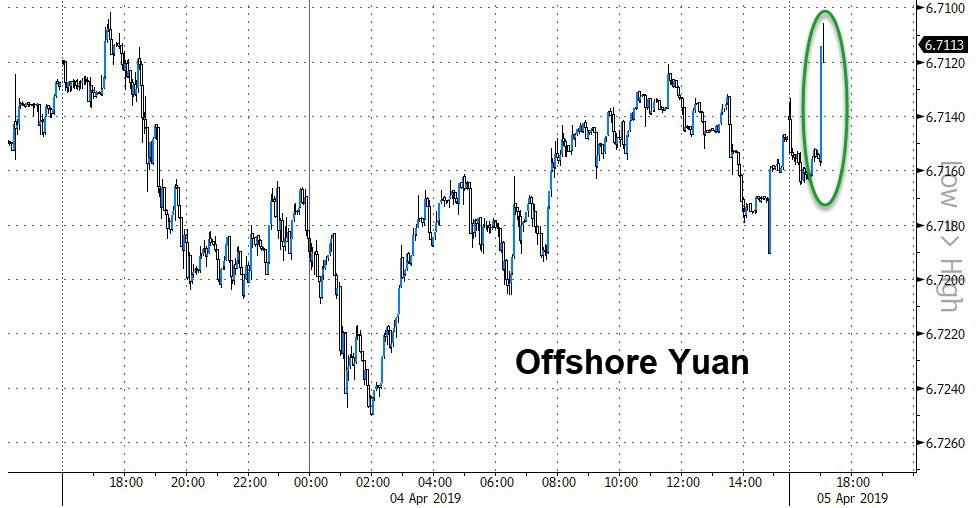Nonfarm payrolls are expected to revert to a more trend-like pace in March, following the sub-par Feb data (which was likely due to one-time effects, according to analysts). The jobless rate is seen remaining at 3.8%. Wage growth is seen moderating a touch, though would still be consistent with the recent pick-up.
Here, courtesy of RanSquawk are the key sellside expectations for the payrolls report:
- Non-farm Payrolls: Exp. 180k, Prev. 20k.
- Unemployment Rate: Exp. 3.8%, Prev. 3.8% (the FOMC currently projects unemployment will stand at 3.7% at the end of 2019, and 4.3% in the longer-run).
- Avg Earnings Y/Y: Exp. 3.3%, Prev. 3.2%.
- Avg Earnings M/M: Exp. 0.3%, Prev. 0.4%.
- Avg Work Week Hours: Exp. 34.5hrs, Prev. 34.4hrs.
- Private Payrolls: Exp. 170k, Prev. 25k.
- Manufacturing Payrolls: Exp. 10k, Prev. 4k.
- Government Payrolls: Prev. -5k.
- U6 Unemployment Rate: Prev. 7.3%.
- Labour Force Participation: Prev. 63.2%.
EXPECTATIONS: The sub-par 20k payroll addition in February was likely lowered by payback from unusually strong increases in previous months and idiosyncratic effects such as weather, Nomura says. This month, nonfarm payrolls are expected at 180k (range: 120k-282k); unemployment rate exp unchanged at 3.8%. If the consensus is correct, payroll growth would still be beneath its 3-, 6- and 12-month averages (12-month average 209k, 6-month average 190k, 3-month average 186k).
WAGES: Average hourly earnings are expected to be unchanged at 3.4% Y/Y, 0.2% M/M vs prior 0.4%; average weekly hours exp 34.5hrs vs 34.4hrs prior. The pace of wage gains is seen moderating a touch in the month. Citi says that while this is a softer increase than last month’s upside surprise, it is still a pace consistent with the recent acceleration in wage gains. “It continues to be our expectation that with a low unemployment rate and a wage-Phillips curve relationship that is alive-and well, wage gains can continue in the recent 3.0-3.5%YoY range for much of this year,” Citi says, but says that wage gains will not be significantly passed through to higher consumer prices. “After likely remaining somewhat below 2% for much of 2019, core PCE is likely to stabilize closer to 2% only later in the second half of the year.”
CLAIMS DATA: In the survey week, initial jobless claims fell by 8k to 216k (with the 4-week moving average rising slightly to 220.5k). That compares with 213k in the February survey period, (where the 4-week moving average was 229.5k). The data in the March survey week might be explained by unfriendly seasonals, Pantheon Macroeconomics noted. “The trend in claims has nudged higher as growth has slowed, thanks mostly to the fading of the tax cuts and the hit to manufacturing from China’s slowdown and the trade war,” adding that the trend-rate is probably around 225K, but that is expected to move higher into the spring. The consultancy argued that this was not the end-of-the-cycle surge in claims, which is more likely to come next year or even as late as 2021.
ADP PAYROLLS: ADP reported 129k payrolls were added to the US economy in March, disappointing the consensus looking for 175k. Pantheon Macroeconomics reminds us that ADP’s model incorporates prior official payroll data as well as information from firms which use its payroll processing services, so it’s possible that the fluke 25K private payroll number for February pulled down the March ADP. “Frustratingly, the influence of the prior month’s official numbers is impossible to isolate consistently in advance,” Pantheon writes, “usually, the effect of weak official numbers on the next ADP reading is seen in the month after severe weather events — February’s survey week was much colder than January’s, relative to seasonal norms — and typically the official number for the month after the weather event is stronger than ADP.” Pantheon goes on to say that the first alternative story, in which ADP has captured a real downshift in payroll growth, cannot be ruled out, “but is very hard to square with the survey evidence and the newly-revised, lower, jobless claims numbers,” and “the final possibility is that greater-than-usual snow cover in March, relative to February — adjusted for seasonal norms — hit March payrolls, despite only modestly colder-than-usual temperatures,” and the uncertainty here is huge, “so prudence dictates that we nudge down our forecast for the official number to about 160K from 180K, but this is a very tricky call.”
ISM SURVEYS: The manufacturing ISM report saw the employment sub-index jump by 5.2 points to 57.5 in March, signalling that employment has grown for a thirtieth straight month. “Employment continued to expand, improving on February’s performance and achieving its highest expansion level since November 2018, when the index registered 57.7 percent,” ISM said (reading above 50.8 percent, over time, is generally consistent with an increase in the Bureau of Labor Statistics (BLS) data on manufacturing employment). The rise in the services report was more modest at 0.7 points, taking the sub-index to 55.9 (registering the 61st consecutive month of expanding jobs in the services sector). Respondents said “staffing up as business grows” and “Difficulty recruiting in a full employment environment.”
CHALLENGER JOB CUTS: US employers are planning to cut 60,587 jobs from payrolls in March, Challenger reported, -21% M/M. Challenger also notes that in Q1 as a whole, job cuts were up 10.3% Q/Q and +35.6% higher than Q1 2018. “Companies appear to be streamlining and updating their processes, and workforce reductions are increasingly becoming a part of these decisions. Consumer behaviour and advances in technology are driving many of these cuts,” Challenger said, adding “another major driver of the uptick in job cuts is economic uncertainty and fears of an upcoming downturn. Companies are reacting to market conditions as much as consumer demand.”
Arguing for a stronger report, via Goldman Sachs:
Winter weather. Winter weather likely lowered job growth in February by around 100k, much of which itself reflected payback from the relatively mild weather in December and January. In March, survey-week snowfall swung from above-average to below-average, with a 1.3-inch seasonally adjusted decline vs. February (population-weighted basis, see Exhibit 1), and our payroll forecast embeds a boost from weather of around 20k, relative to trend.
Jobless claims. Initial jobless claims declined over the four weeks between the payroll reference periods (-5k to 221k on average, lowest since November). Continuing claims also fell from survey week to survey week (-18k to 1,755k), but we currently place much more weight on the initial claims reading due to the likely impact of residual seasonality.
Business surveys. While business survey headline indices were mixed-to-weaker in March[1], the employment components of both the services and manufacturing employment trackers generally increased (+1.2pt to 55.2 and +1.3pt to 57.0, respectively). Taken together, business surveys suggest a solid rebound in job growth in March, but with an underlying pace somewhat below what was seen in mid-2018 (see Exhibit 2). Service-sector job growth rose 57k in February and averaged 156k over the last six months. Manufacturing payroll employment rose 4k in February and increased 20k on average over the last six months.
Arguing for a weaker report:
Job availability. The Conference Board labor market differential—the difference between the percent of respondents saying jobs are plentiful and those saying jobs are hard to get—declined by 5.7pt to +28.3 in March, its largest monthly decline since February 2009 (see left panel of Exhibit 3). While concerning, this weakness may be telling us more about February than about March, as the widely reported payrolls miss at a time when recession fears were rising may have influenced survey responses. While we do not have a detailed demographic breakdown for the Conference Board measure, the UMich “unfavorable employment news” component rose by 10pp among higher-income consumers—who on average are more likely to follow financial news—whereas it rose only 0.5pp across the other two thirds of the income distribution. As shown in the right panel of the same exhibit, changes in the Conference Board labor market differential are somewhat predictive of payroll surprises, but the relationship breaks down following large misses in the previous month (i.e. the best fit line actually slopes downward for the dark blue datapoints).
ADP. The payroll-processing firm ADP reported a 129k increase in March private payroll employment—46k below consensus and well below the +214k average pace over the prior six months. The March ADP report suggests that the underlying pace of job growth is moderating, though some of the weakness probably reflects a mechanical drag from prior-month nonfarm payroll growth (an input to the ADP model). We also note that weather tends to affect the official payroll measure more so than it affects the ADP series (a positive factor this month, in our view).
ADP. The payroll-processing firm ADP reported a 129k increase in March private payroll employment—46k below consensus and well below the +214k average pace over the prior six months. The March ADP report suggests that the underlying pace of job growth is moderating, though some of the weakness probably reflects a mechanical drag from prior-month nonfarm payroll growth (an input to the ADP model). We also note that weather tends to affect the official payroll measure more so than it affects the ADP series (a positive factor this month, in our view).
Neutral factors:
Job cuts. Announced layoffs reported by Challenger, Gray & Christmas declined by 11k in March to 55k (SA by GS). Announced job cuts in March are slightly below their March 2018 level (-1k yoy).
via ZeroHedge News http://bit.ly/2CWpicI Tyler Durden
